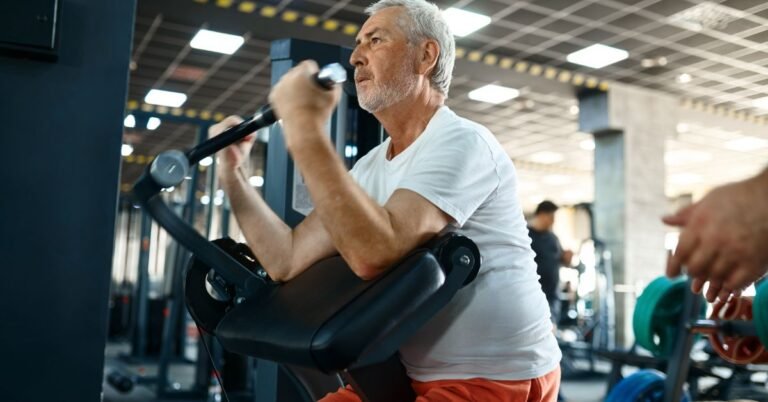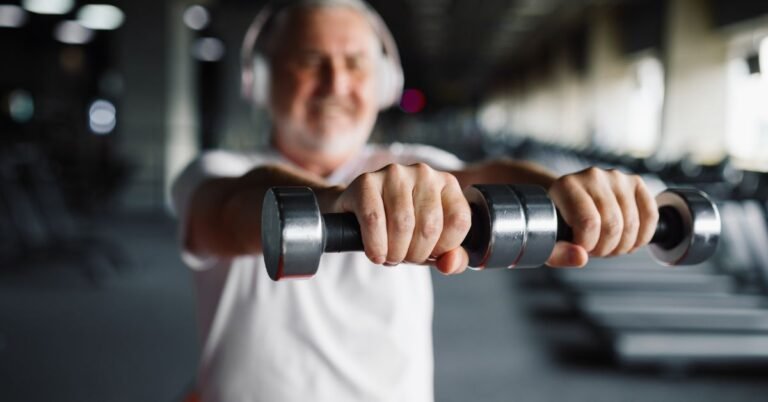*This article was originally uploaded as a guest post on Lift Team 6
Have you ever discussed weight training with the older adults in your life?
Here’s why you should get your parents to start resistance training!
Strength training and lifting weights is becoming increasingly recognised as an essential form of exercise throughout our lives, with particular importance into older age. There are a vast number of changes that our bodies go through as we age, and one of the best ways that we can protect our health, happiness, mental functioning and longevity is through resistance training. This means not only remain ‘generally’ active as we have traditionally been advised, but also ensuring that we are performing muscle strengthening exercises on a regular basis.
Strength training can be started at any age in order to reap its numerous benefits. Starting early and continuing throughout life is definitely the best bet – but that doesn’t mean reaching older age is too late. An increasing body of evidence is demonstrating the significant health benefits of strength training into older age. One of the most positive influences we could have on our parents right now is to advise them to start regular resistance training. The folks at Keeping Strong have helped to put together this fantastic overview exploring the physiological effects of ageing on the body, and the profound benefits of strength training. Have a read and SHARE with your parents, friends, and loved ones to get them started on their strength training journey today!

Chronic disease and all-cause-mortality
The primary risk factor for the most serious chronic diseases is unfortunately age, including cardiovascular diseases, diabetes, and cancer. Other significant risk factors are modifiable lifestyle factors, such as physical activity levels, nutrition and levels of smoking and alcohol intake.
Cardiovascular diseases are currently the biggest killers in western societies. Being physically active reduces your risk of cardiovascular disease by up to 35% (1). Although cardiovascular health has traditionally been linked to aerobic forms of exercise, there is growing evidence demonstrating the beneficial effects of strength training on cardiovascular risk factors (2, 3). These include positive effects on key determinants of cardiovascular health: glycaemic control, insulin action, blood pressure, vascular function and blood lipids (2).
Strength training programmes are recommended for middle to older age adults to prevent the onset of diabetes, as well as for its management (4, 5). Muscle mass and strength are independently associated with cardiovascular disease risk and death (6). Studies comparing aerobic and resistance training programmes have actually shown comparative beneficial cardiovascular effects, and even comparative effects for lower intensity resistance programmes (6). However studies which include groups performing both resistance and aerobic training demonstrate enhanced benefits (7, 8). Therefore the current recommendations are to perform a combination of strength and aerobic exercise for optimal health benefits. Current public health guidelines for older adults are 150 minutes of moderate intensity exercise (or 75 minutes of high intensity exercise), and at least two strength training sessions a week (9).
Insufficient levels of physical activity has also been found to drastically increase the risk of a number of types of cancer, and death from these cancers. Again, traditionally the idea of increasing physical activity levels has focused on aerobic forms of fitness – however numerous studies show significant reductions in cancer recurrence, cancer deaths, and unwanted side effects with regularly performed strength training (6). At this point most of this evidence comes from breast and prostate cancer, but the evidence across a range of different types of cancers is growing.
Unsurprisingly given the effects on all of the above chronic age-related diseases, strength training is associated with a reduced risk of all-cause mortality (that is death of any cause!) (4, 10, 11).
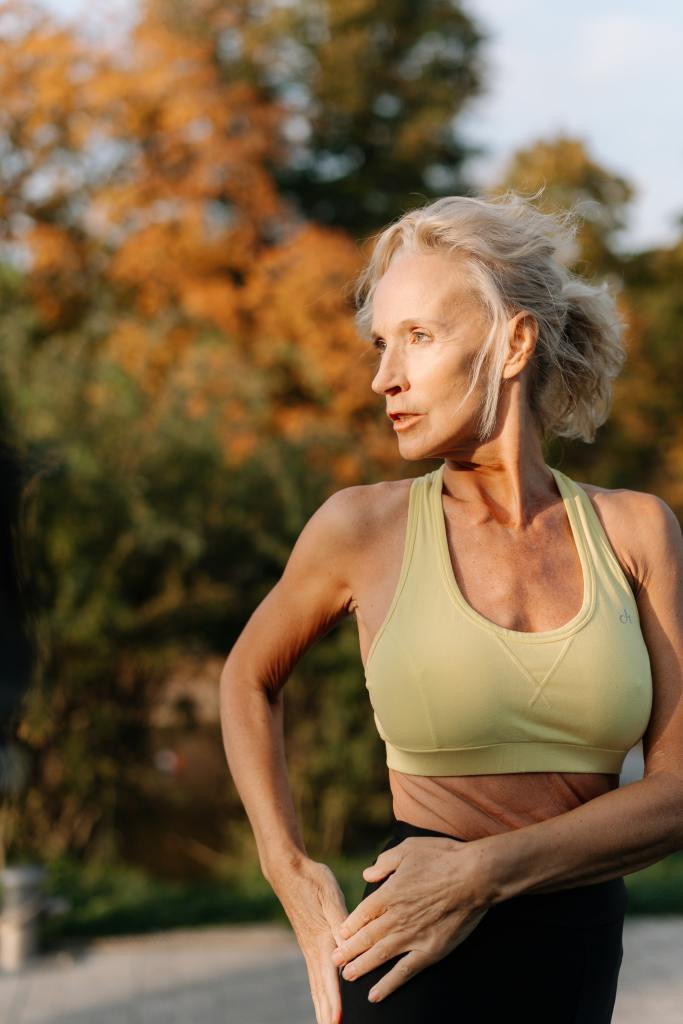
Muscle mass and strength
We all know that resistance training and lifting weights builds muscle and strength. The thought of strength training likely brings images to mind of young men bicep curling in front of the mirror in carefully chosen vests. But this is certainly not a practice that should be reserved just for younger men looking to bulk up. Maintaining and building muscle mass and strength is actually vital at every point of our lives. Our muscles are what allow us to move, walk, climb stairs, get out of bed, and run etc. Unfortunately our muscles cannot look after themselves.
The natural ageing process leads to a loss of muscle strength and mass. It is a complicated process with many causes which unfortunately starts much earlier than most of us would care to accept. This loss of muscle mass and strength has detrimental consequences as we grow older. Sarcopenia is a term used to describe the age-related syndrome of progressive and generalised loss of skeletal muscle strength and mass in older age; it is associated with frailty, falls, an ability to carry out day to day functional tasks, reduced independence and quality of life, and premature death (12).
Generally we reach our peak physical capacity for muscle mass, strength and power between 20 and 30 years old. From the age of 30 to about 50, there is a gradual reduction in muscle mass, strength and power; at this point, although these reductions are pretty small, they are cumulative and variations are seen in different populations (sex, genetics, lifestyle factors etc have large effects on this). From the age of 50, there is a stark increase in this loss: a number of studies have found a strength loss of 15% per decade from the age of 50. Some studies suggest this acceleration may even begin as early as our 40s! (13).
The pathophysiology of this loss of muscle strength and mass is complex. There is a reduction in motor units, neurons; and number, type, and size of muscle fibers. The rate of synthesis of muscle protein rapidly declines (14, 15, 16), causing a switch in the carefully balanced muscle protein synthesis vs muscle protein breakdown in the wrong direction. The causes are multifactorial- some of which are inevitable age-related hormonal and cellular changes (17). However, critical factors in the loss of muscle mass and strength are under our control: most notably, the decrease in physical activity that commonly occurs with ageing, and poor nutritional intake. Importantly there is now strong evidence to show that progressive resistance training:
1) Improves the muscle strength and mass of older adults (18)
2) Is safe to carry out for older adults (18)
3) Improves their ability to carry out daily activities (i.e. walking, stair climbing, standing from a chair) (18).
4) Maintains independence and improves quality of life (18, 19, 20, 21)
This is what we all care about and would want for our family and friends, right? Being able to live into older age, continuing to carry out the activities we want to perform, and maintaining our independence. Low muscle mass, strength, and bone density as we grow older mean that normal movements and activities become increasingly difficult; with the additional risk of falls and possible injury potentially exacerbating the loss of independence further.
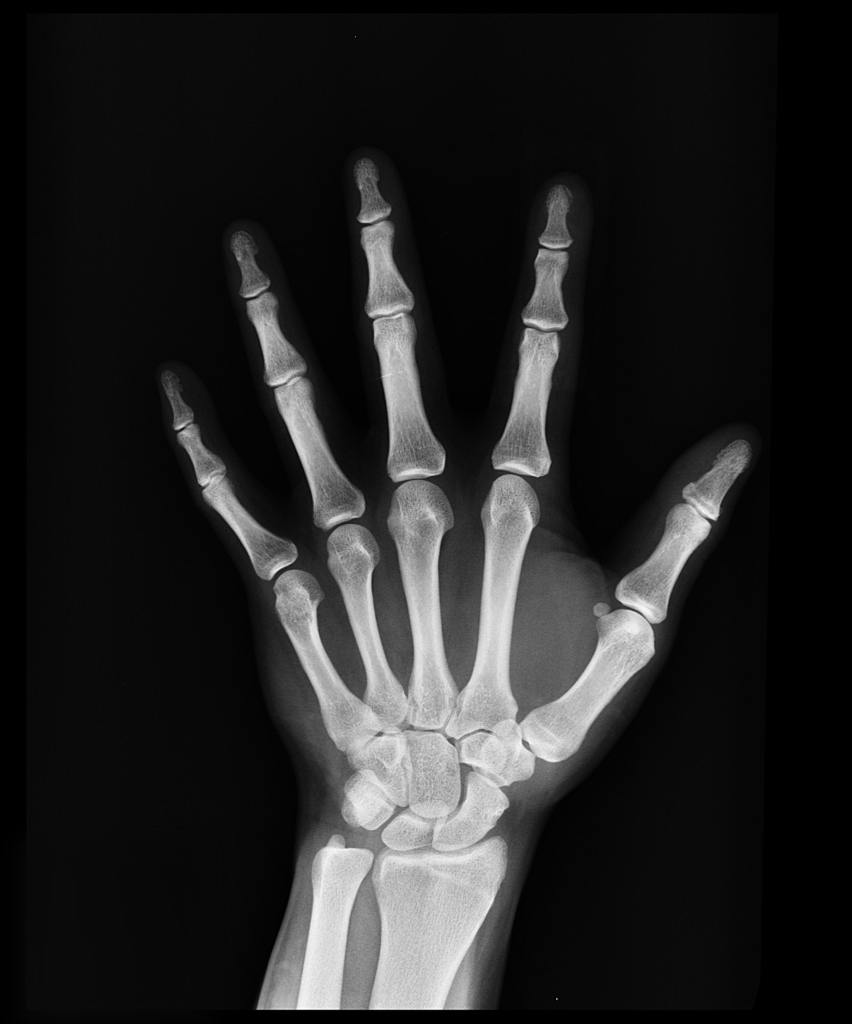
Bone density
There is also a loss of bone mass as we age, known as osteopenia, which can progress to osteoporosis. The process is again multifactorial, but has been shown to have strong associations with genetics, nutrition, and lifestyle factors such as physical activity levels. Bone homeostasis throughout the early parts of our lives involves a well-balanced system of bone resorption (osteoclast activity) and new bone formation (osteoblast activity) – our bones are constantly being remodelled involving numerous cellular signalling messengers and hormones (22). From roughly the age of 50, the bone resorption activity starts to surpass the bone formation activity, meaning bone density gradually decreases. A number of physiological and hormonal changes tip this balance in the wrong direction. For females this often happens earlier due to the loss of oestrogen and other hormonal changes occurring in the menopause (23). However these changes also happen in males, with decreases in oestrogen, testosterone and other growth hormones.
Strong bones are essential to allow our bodies to move easily and optimally. Low bone mineral density predisposes a person to fractures- even from minor falls or impacts! Common and severe fracture sites are the hip and spine. The pain, functional limitations, loss of independence, and serious psychological consequences of these fractures are huge. Hip fractures alone carry a roughly 30% risk of death within 1 year of sustaining the injury (24).
Weight-bearing activity and sustaining load through bones is known to stimulate an increase in bone mineral density. Strength and resistance exercises have been shown to effectively increase bone mineral density in all ages, and even in osteoporotic patients (25). The key to these strength exercises is to ensure the resistance or the load is challenging, and exceeds the forces of normal daily activities. Strength training should be performed throughout life in order to ensure peak bone mass, maintenance of this mass, and as little loss as possible!

Weight loss
Our resting metabolic rate is largely determined by our muscle mass: larger muscle mass means we burn more calories at rest. Increasing muscle mass via strength training therefore has an obvious chronic effect on our resting metabolic rates. The strength training sessions themselves also cause acute elevations in metabolic rates due to muscular tissue repairing and remodelling. In some studies this acute elevation in resting metabolic rate lasts for up to 3 days after a session (26)!
This increase in metabolic rate is a key component of weight loss; importantly the incorporation of strength training ensures this weight loss is focused on fat loss rather than lean muscle mass (27). This is obviously especially important into older age, when there is a natural rise in our fat mass and loss of muscle mass. Regular resistance training programmes reduce total body fat mass in older men and women, independent of calorie consumption (28); with numerous studies highlighting a significant reduction in visceral adiposity- an area of fat accumulation associated with a number of cardiovascular and chronic diseases. Other studies comparing dieting, with the addition of either resistance training or aerobic training, have demonstrated comparable weight loss between groups of older adults, but larger fat mass loss in groups with resistance training (29). However, again it seems that the combination of strength and aerobic training leads to the greatest overall benefits. Studies including groups who performed both show comparable weight loss, as well as the additional fat mass loss and maintenance of muscle mass in the strength training alone groups, as well as the cardiovascular benefits of aerobic training alone groups.

Reduced levels of chronic pain
Chronic musculoskeletal pain is extremely common in the general population- that is pain felt in the muscles, joint or bones lasting over 3 months. Common areas affected are the back, neck, knees, hips, and shoulders. Unfortunately these conditions are becoming very prevalent and are more so as we age. The impacts of chronic pain conditions are huge for the individual, their social interactions, and wider society. Modern medicine is slowly moving away from the traditional pharmaceutical and passive approach to treating these types of conditions, to a more active approach- empowering individuals to take control of their own pain and lifestyles, with increased physical activity levels being one of the key messages. High quality research supports the analgesic (pain relieving) effect of exercise on these conditions, acutely, and chronically, when performed regularly. The exact mechanisms of the effects of exercise on pain are far from fully understood but the research so far suggests: a central effect on pain through the release of endogenous pain modulatory hormones; reconceptualising the threat/fear of movement within the brain; improving levels of self-efficacy; as well as a number of physiological changes at cellular levels (which in simple terms may dampen down some of the heightened areas of sensitivity) (30).
There is strong evidence specifically for the positive effects of strength training on chronic lower back pain (31) (32), neck pain (33) (34), shoulder pain (35), fibromyalgia (36), knee osteoarthritis pain (37) and tendinopathy (pain and symptoms arising from a tendon i.e. the achilles, rotator cuff or patellar tendon) (38).

Stress, anxiety, depression
The vast benefits of physical activity on our mental health are clear. We all know we feel better after a workout right!? The post workout high?! The physiological mechanisms behind the impact of exercise on our mood are complex and not fully understood. It is thought to be related to increased circulation, activation of certain areas of the brain associated with our emotions and mood, the release of ‘happy’ hormones, as well as wider effects on feelings of self-efficacy and self-esteem, distraction, and potential social interaction (depending on the context).
Numerous studies support the positive effects of exercise on stress levels, anxiety, mood and depression in a variety of populations (39). These include studies on healthy individuals and individuals with diagnosed mental health conditions. In the past the focus of exercise for mental health benefits has centred on aerobic type exercise. However a comprehensive research review has highlighted the positive mental health benefits of strength training: specifically on symptoms of anxiety, depression and self-esteem; this also includes positive effects shown on adults with clinically diagnosed depression (40). The differing effects of resistance training on our mood compared to aerobic training hasn’t yet been fully explored, but are thought to be related to long term neuro-physiological adaptations in our brain circuitry and firing- it’s pretty cool that we have the ability to affect the wiring and firing in our brains to help our mental health!
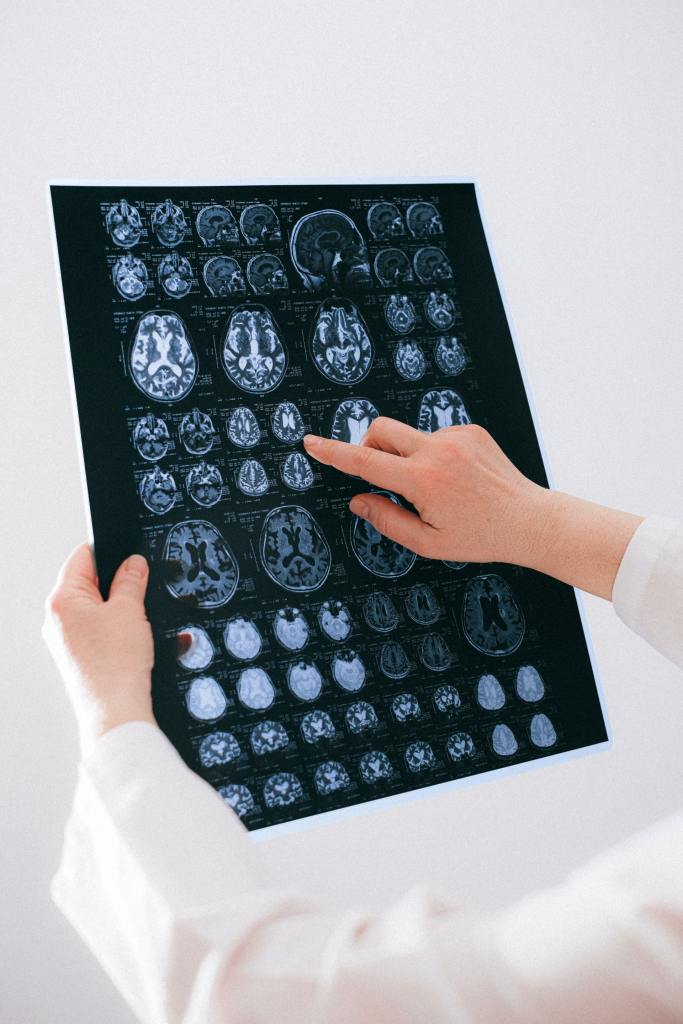
Brain health, cognition, memory
Following along the same lines, resistance training has been shown to improve a range of aspects of cognition in older adults, including marked improvements in memory and executive functioning (40). Most studies have looked at the improvements in cognitive abilities with aerobic and endurance training, with vast improvements found time and time again (41). People who engage in regular physical activity have a significantly lower risk of developing cognitive impairments and dementia (42). The physiological mechanisms behind this include the upregulation of growth factors in the brain, improvements in cardiovascular health, enhanced neuroplasticity, and reductions in chronic stress hormones and levels of systemic inflammation known to affect cognition (42).
Although most studies have focused on the effects of aerobic activity, studies looking at resistance training alone have shown significant benefits of cognitive abilities, and a meta-analysis of studies demonstrated that the addition of resistance training to aerobic activity led to greater cognitive improvements than aerobic activity alone (26).
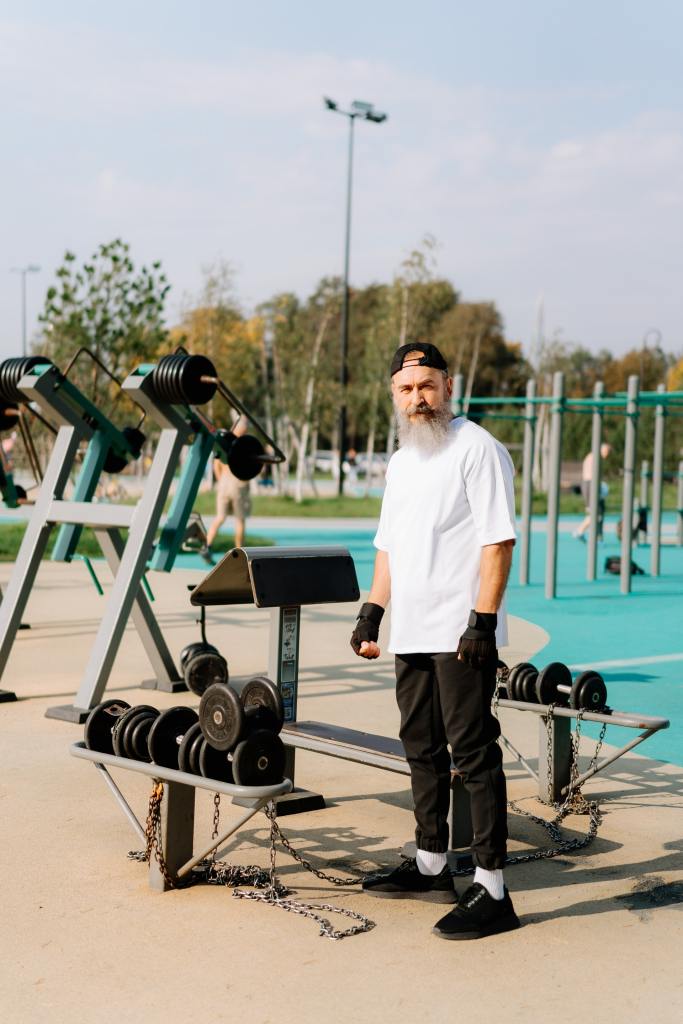
Immune system
Exercise has direct and indirect effects on our immune system, both in the short term from acute bouts of exercise and chronically from regularly engaging in exercise. Direct effects include ‘priming’ immune cells to perform more effectively (including increased surveillance in our circulation, improved ‘killer’ effects, and increased recognition of antigens and foreign substances); indirect and longer term effects include reprogramming of immune cells, systematic anti-inflammatory signalling, and positive effects on our lymphatic circulation (43). These effects have been shown following acute bouts of aerobic and resistance exercise (44).
Our immune systems unfortunately decline as we get older, a term known as ‘immunosenescence’; affecting the innate and adaptive immune systems and increased levels of systemic inflammation. These changes are associated with reduced immunosurveillance, increased susceptibility to infections, reduced response to vaccinations, and increased incidence of a range of types of cancer.
But, as always… have hope! Fortunately an increasing body of evidence supports the participation in regular moderate-intensity activity across our lifespans to slow down, or even prevent a number of these changes (45) (46).
So far insufficient research has been carried out to determine exactly the specific types, intensity, or frequency of exercise needed to achieve these immune health benefits. Specifically, not enough studies have investigated the effects of long term strength training on our immune health. However, the acute effects of strength training on our immune health have been demonstrated, and skeletal muscle is known to be a major immune regulatory organ (46). And, as we already know, skeletal muscle mass is naturally lost in ageing, but regular strength training ensures that we maintain or even improve this mass. Therefore we are certain that more time and studies will demonstrate the vast immune benefits of regularly engaging in strength training on immunity across our lifespan.
So there we have it, if you want to invest in your own long term health or help to protect the older adults in your life then there’s no better time to take resistance training seriously. If you’d like more information focusing on the world of strength training for older adults make sure to check out the Keeping Strong blog.
References
2.Braith, R., & Stewart, K. (2006). Resistance Exercise Training. Circulation, 113(22), 2642-2650.
3.Williams, M., & Stewart, K. (2009). Impact of Strength and Resistance Training on Cardiovascular Disease Risk Factors and Outcomes in Older Adults. Clinics In Geriatric Medicine, 25(4), 703-714.
4.Flack, K., Davy, K., Hulver, M., Winett, R., Frisard, M., & Davy, B. (2011). Aging, Resistance Training, and Diabetes Prevention. Journal Of Aging Research, 2011, 1-12.
5.Strasser, B., Siebert, U., & Schobersberger, W. (2010). Resistance Training in the Treatment of the Metabolic Syndrome. Sports Medicine, 40(5), 397-415.
6.Mcleod, J., Stokes, T., & Phillips, S. (2019). Resistance Exercise Training as a Primary Countermeasure to Age-Related Chronic Disease. Frontiers In Physiology, 10.
7.Schroeder, E., Franke, W., Sharp, R., & Lee, D. (2019). Comparative effectiveness of aerobic, resistance, and combined training on cardiovascular disease risk factors: A randomized controlled trial. PLOS ONE, 14(1), e0210292.
8.Ho, S., Dhaliwal, S., Hills, A., & Pal, S. (2012). The effect of 12 weeks of aerobic, resistance or combination exercise training on cardiovascular risk factors in the overweight and obese in a randomized trial. BMC Public Health, 12(1).
10.Saeidifard, F., Medina-Inojosa, J., West, C., Olson, T., Somers, V., & Bonikowske, A. et al. (2019). The association of resistance training with mortality: A systematic review and meta-analysis. European Journal Of Preventive Cardiology, 26(15), 1647-1665.
11.Dankel, S., Loenneke, J., & Loprinzi, P. (2016). Dose-dependent association between muscle-strengthening activities and all-cause mortality: Prospective cohort study among a national sample of adults in the USA. Archives Of Cardiovascular Diseases, 109(11), 626-633.
12.Jones, T., Stephenson, K., King, J., Knight, K., Marshall, T., & Scott, W. (2001). Sarcopenia–mechanisms and treatments. Journal Of Geriatric Physical Therapy, 32(2), 83-89.
13.Keller, K., & Engelhardt, M. (2014). Strength and muscle mass loss with aging process. Age and strength loss. Muscle Ligaments And Tendons Journal, 03(04), 346-350.
14.Morley, J., Baumgartner, R., Roubenoff, R., Mayer, J., & Nair, K. (2001). Sarcopenia. Journal Of Laboratory And Clinical Medicine, 137(4), 231-243.
15.Deschenes, M. (2004). Effects of Aging on Muscle Fibre Type and Size. Sports Medicine, 34(12), 809-824.
16.Thompson, L., 2009. Age-related muscle dysfunction. Experimental Gerontology, 44(1-2), pp.106-111.
17.Evans, W., 2010. Skeletal muscle loss: cachexia, sarcopenia, and inactivity. The American Journal of Clinical Nutrition, 91(4), pp.1123S-1127S.
18.Liu, C. and Latham, N., 2009. Progressive resistance strength training for improving physical function in older adults. Cochrane Database of Systematic Reviews,.
19.Liu, C., Shiroy, D., Jones, L. and Clark, D., 2014. Systematic review of functional training on muscle strength, physical functioning, and activities of daily living in older adults. European Review of Aging and Physical Activity, 11(2), pp.95-106.
20.Olsen, P., Termannsen, A., Bramming, M., Tully, M. and Caserotti, P., 2019. Effects of resistance training on self-reported disability in older adults with functional limitations or disability – a systematic review and meta-analysis. European Review of Aging and Physical Activity, 16(1).
21.Hart, P. and Buck, D., 2019. The effect of resistance training on health-related quality of life in older adults: Systematic review and meta-analysis. Health Promotion Perspectives, 9(1), pp.1-12.
22.Chen, X., Wang, Z., Duan, N., Zhu, G., Schwarz, E. and Xie, C., 2017. Osteoblast–osteoclast interactions. Connective Tissue Research, 59(2), pp.99-107.
23.https://www.hopkinsmedicine.org/health/conditions-and-diseases/osteoporosis
24.https://www.gmjournal.co.uk/mortality-post-hip-fractures
25.Benedetti, M., Furlini, G., Zati, A. and Letizia Mauro, G., 2018. The Effectiveness of Physical Exercise on Bone Density in Osteoporotic Patients. BioMed Research International, 2018, pp.1-10.
26.Westcott, W., 2012. Resistance Training is Medicine. Current Sports Medicine Reports, 11(4), pp.209-216.
27.Avila, J., Gutierres, J., Sheehy, M., Lofgren, I. and Delmonico, M., 2010. Effect of moderate intensity resistance training during weight loss on body composition and physical performance in overweight older adults. European Journal of Applied Physiology, 109(3), pp.517-525.
28.HUNTER, G., BRYAN, D., WETZSTEIN, C., ZUCKERMAN, P. and BAMMAN, M., 2002. Resistance training and intra-abdominal adipose tissue in older men and women. Medicine & Science in Sports & Exercise, 34(6), pp.1023-1028.
29.Beavers, K., Ambrosius, W., Rejeski, W., Burdette, J., Walkup, M., Sheedy, J., Nesbit, B., Gaukstern, J., Nicklas, B. and Marsh, A., 2017. Effect of Exercise Type During Intentional Weight Loss on Body Composition in Older Adults with Obesity. Obesity, 25(11), pp.1823-1829.
30.Smith, B., Hendrick, P., & Bateman, M. (2019). Musculoskeletal pain and exercise—challenging existing paradigms and introducing new. British Journal Of Sports Medicine, 53, 907-912.
31.Wewege, M., Booth, J., & Parmenter, B. (2018). Aerobic vs. resistance exercise for chronic non-specific low back pain: A systematic review and meta-analysis. Journal Of Back And Musculoskeletal Rehabilitation, 31(5), 889-899.
32.Searle, A., Spink, M., Ho, A., & Chuter, V. (2015). Exercise interventions for the treatment of chronic low back pain: a systematic review and meta-analysis of randomised controlled trials. Clinical Rehabilitation, 29(12), 1155-1167.
33.Li, X., Lin, C., Liu, C., Ke, S., Wan, Q., & Luo, H. et al. (2017). Comparison of the effectiveness of resistance training in women with chronic computer-related neck pain: a randomized controlled study. International Archives Of Occupational And Environmental Health, 90(7), 673-683.
34.Saeterbakken, A., Makrygiannis, P., Stien, N., Solstad, T., Shaw, M., Andersen, V., & Pedersen, H. (2020). Dose-response of resistance training for neck-and shoulder pain relief: a workplace intervention study. BMC Sports Science, Medicine And Rehabilitation, 12(1).
35.Naunton, J., Street, G., Littlewood, C., Haines, T., & Malliaras, P. (2020). Effectiveness of progressive and resisted and non-progressive or non-resisted exercise in rotator cuff related shoulder pain: a systematic review and meta-analysis of randomized controlled trials. Clinical Rehabilitation, 34(9), 1198-1216.
36.Andrade, A., de Azevedo Klumb Steffens, R., Sieczkowska, S., Peyré Tartaruga, L., & Torres Vilarino, G. (2018). A systematic review of the effects of strength training in patients with fibromyalgia: clinical outcomes and design considerations. Advances In Rheumatology, 58(1).
37.Nguyen, C., Lefèvre-Colau, M., Poiraudeau, S., & Rannou, F. (2016). Rehabilitation (exercise and strength training) and osteoarthritis: A critical narrative review. Annals Of Physical And Rehabilitation Medicine, 59(3), 190-195.
38.Kristensen, J., & Franklyn-Miller, A. (2011). Resistance training in musculoskeletal rehabilitation: a systematic review. British Journal Of Sports Medicine, 46(10), 719-726.
39.Rahman, M., El Werfalli, R., & Lehmann-Waldau, F. (2017). Current Evidence and Use of Physical Activity in the Treatment of Mental Illness: A Literature Review. Deutsche Zeitschrift Für Sportmedizin, 2017(04), 93-100.
40.O’Connor, P., Herring, M., & Caravalho, A. (2010). Mental Health Benefits of Strength Training in Adults. American Journal Of Lifestyle Medicine, 4(5), 377-396.
41.Zheng, G., Xia, R., & Zhou, W. (2016). Aerobic exercise ameliorates cognitive function in older adults with mild cognitive impairment: a systematic review and meta-analysis of randomised controlled trials. British Journal Of Sports Medicine, 50, 1443-1450.
42.Quigley, A., MacKay-Lyons, M., & Eskes, G. (2020). Effects of Exercise on Cognitive Performance in Older Adults: A Narrative Review of the Evidence, Possible Biological Mechanisms, and Recommendations for Exercise Prescription. Journal Of Aging Research, 2020, 1-15.
43.Hoff, P., Belavý, D., Huscher, D., Lang, A., Hahne, M., & Kuhlmey, A. et al. (2014). Effects of 60-day bed rest with and without exercise on cellular and humoral immunological parameters. Cellular & Molecular Immunology, 12(4), 483-492.
44.Nieman, D., & Wentz, L. (2019). The compelling link between physical activity and the body’s defense system. Journal Of Sport And Health Science, 8(3), 201-217.
45.Turner, J. (2016). Is immunosenescence influenced by our lifetime “dose” of exercise?. Biogerontology, 17(3), 581-602.
46.Duggal, N., Niemiro, G., Harridge, S., Simpson, R., & Lord, J. (2019). Can physical activity ameliorate immunosenescence and thereby reduce age-related multi-morbidity?. Nature Reviews Immunology, 19(9), 563-572.


